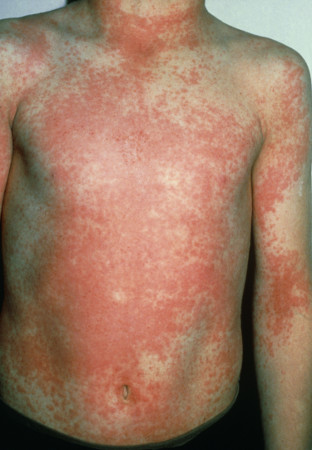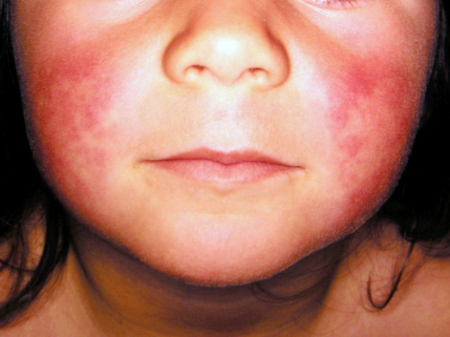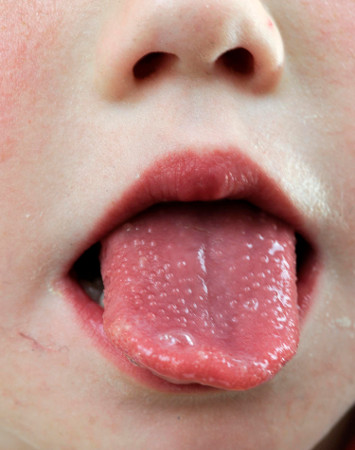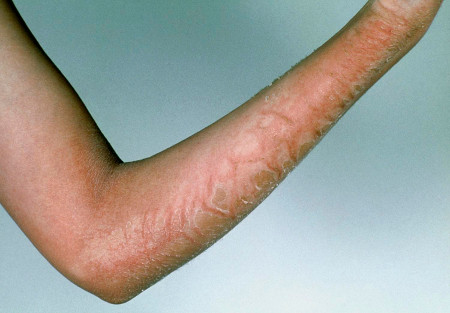Have a high index of clinical suspicion for scarlet fever in a child or adolescent who presents with the triad of sore throat, fever (>100.4°F [>38.0°C]), and a scarlatiniform abdominal rash (i.e., a diffuse, finely papular [sandpaper-like], erythematous rash that blanches with pressure).[2]Shulman ST, Bisno AL, Clegg HW, et al. Clinical practice guideline for the diagnosis and management of group A streptococcal pharyngitis: 2012 update by the Infectious Diseases Society of America. Clin Infect Dis. 2012 Nov 15;55(10):e86-102. [Erratum in: Clin Infect Dis. 2014 May;58(10):1496.]
https://academic.oup.com/cid/article/55/10/e86/321183
http://www.ncbi.nlm.nih.gov/pubmed/22965026?tool=bestpractice.com
[3]American Academy of Pediatrics. Group A streptococcal infections. In: Kimberlin DW, Barnett ED, Lynfield R, et al, eds. Red book: 2021-2024 report of the Committee on Infectious Diseases, 32nd ed. Itasca, IL: American Academy of Pediatrics; 2021.
https://publications.aap.org/redbook
Be aware that the scarlet fever rash can be confused with measles. See Differentials.
Scarlet fever can occur at any age but mainly affects children ages 1-10 years, and it is most common in those ages 3-6 years. It is uncommon in children <1 year old and in adults.[5]Lamagni T, Guy R, Chand M, et al. Resurgence of scarlet fever in England, 2014-16: a population-based surveillance study. Lancet Infect Dis. 2018 Feb;18(2):180-7.
https://www.thelancet.com/journals/laninf/article/PIIS1473-3099(17)30693-X/fulltext
http://www.ncbi.nlm.nih.gov/pubmed/29191628?tool=bestpractice.com
[6]Liu Y, Chan TC, Yap LW, et al. Resurgence of scarlet fever in China: a 13-year population-based surveillance study. Lancet Infect Dis. 2018 Aug;18(8):903-12.
https://www.thelancet.com/journals/laninf/article/PIIS1473-3099(18)30231-7/fulltext
http://www.ncbi.nlm.nih.gov/pubmed/29858148?tool=bestpractice.com
[7]Staszewska-Jakubik E, Czarkowski MP, Kondej B. Scarlet fever in Poland in 2014. Przegl Epidemiol. 2016;70(2):195-202.
http://www.ncbi.nlm.nih.gov/pubmed/27779834?tool=bestpractice.com
Around 90% of children and adolescents with scarlet fever present with group A streptococcus (GAS) (Streptococcus pyogenes) pharyngitis.[14]Wu S, Peng X, Yang Z, et al. Estimated burden of group a streptococcal pharyngitis among children in Beijing, China. BMC Infect Dis. 2016 Aug 26;16(1):452.
https://bmcinfectdis.biomedcentral.com/articles/10.1186/s12879-016-1775-9
http://www.ncbi.nlm.nih.gov/pubmed/27566251?tool=bestpractice.com
[15]Herdman MT, Cordery R, Karo B, et al. Clinical management and impact of scarlet fever in the modern era: findings from a cross-sectional study of cases in London, 2018-2019. BMJ Open. 2021 Dec 24;11(12):e057772.
https://bmjopen.bmj.com/content/11/12/e057772.long
http://www.ncbi.nlm.nih.gov/pubmed/34952887?tool=bestpractice.com
Both conditions have similar epidemiology, evaluation, and treatment. See Acute pharyngitis.
History
Take a detailed history. Suspect scarlet fever in:
Patients with GAS pharyngitis
Most cases of scarlet fever occur in conjunction with GAS pharyngitis.[3]American Academy of Pediatrics. Group A streptococcal infections. In: Kimberlin DW, Barnett ED, Lynfield R, et al, eds. Red book: 2021-2024 report of the Committee on Infectious Diseases, 32nd ed. Itasca, IL: American Academy of Pediatrics; 2021.
https://publications.aap.org/redbook
While <10% of patients with GAS pharyngitis develop scarlet fever, around 90% of children and adolescents with scarlet fever also present with GAS pharyngitis; therefore, the presence of symptoms (rash, fever, and sore throat) and a diagnosis of GAS pharyngitis are the most important clinical indicators of scarlet fever.[14]Wu S, Peng X, Yang Z, et al. Estimated burden of group a streptococcal pharyngitis among children in Beijing, China. BMC Infect Dis. 2016 Aug 26;16(1):452.
https://bmcinfectdis.biomedcentral.com/articles/10.1186/s12879-016-1775-9
http://www.ncbi.nlm.nih.gov/pubmed/27566251?tool=bestpractice.com
[15]Herdman MT, Cordery R, Karo B, et al. Clinical management and impact of scarlet fever in the modern era: findings from a cross-sectional study of cases in London, 2018-2019. BMJ Open. 2021 Dec 24;11(12):e057772.
https://bmjopen.bmj.com/content/11/12/e057772.long
http://www.ncbi.nlm.nih.gov/pubmed/34952887?tool=bestpractice.com
Note that GAS infection in children <3 years old is often associated with fever, mucopurulent rhinitis, excoriated nares, and diffuse adenopathy, and that exudative pharyngitis is rare in this age group.[2]Shulman ST, Bisno AL, Clegg HW, et al. Clinical practice guideline for the diagnosis and management of group A streptococcal pharyngitis: 2012 update by the Infectious Diseases Society of America. Clin Infect Dis. 2012 Nov 15;55(10):e86-102. [Erratum in: Clin Infect Dis. 2014 May;58(10):1496.]
https://academic.oup.com/cid/article/55/10/e86/321183
http://www.ncbi.nlm.nih.gov/pubmed/22965026?tool=bestpractice.com
Occasionally, especially in children ages <5 years, the scarlatiniform rash and fever can present prior to or independent of symptoms of pharyngitis.[15]Herdman MT, Cordery R, Karo B, et al. Clinical management and impact of scarlet fever in the modern era: findings from a cross-sectional study of cases in London, 2018-2019. BMJ Open. 2021 Dec 24;11(12):e057772.
https://bmjopen.bmj.com/content/11/12/e057772.long
http://www.ncbi.nlm.nih.gov/pubmed/34952887?tool=bestpractice.com
Close contacts of a person with scarlet fever or other GAS presentation (e.g., GAS pharyngitis)
This is the most common risk factor. Clusters or outbreaks of scarlet fever are commonly reported in endemic settings.[10]Centers for Disease Control and Prevention. Scarlet fever: information for clinicians. Jun 2022 [internet publication].
https://www.cdc.gov/groupastrep/diseases-hcp/scarlet-fever.html
The incubation period is approximately 2-5 days.[10]Centers for Disease Control and Prevention. Scarlet fever: information for clinicians. Jun 2022 [internet publication].
https://www.cdc.gov/groupastrep/diseases-hcp/scarlet-fever.html
Household contacts of a person with scarlet fever have been found to have an increased risk of invasive GAS (iGAS) infection in the 2 months following scarlet fever onset, although the risk is relatively low (35.3 cases/100,000 person-years).[16]Watts V, Balasegaram S, Brown CS, et al. Increased risk for invasive group A streptococcus disease for household contacts of scarlet fever cases, England, 2011-2016. Emerg Infect Dis. 2019 Mar;25(3):529-37.
https://wwwnc.cdc.gov/eid/article/25/3/18-1518_article
http://www.ncbi.nlm.nih.gov/pubmed/30602121?tool=bestpractice.com
See Complications.
Children ages 1-10 years
Scarlet fever can occur at any age but mainly affects children ages 1-10 years, and it is most common in children ages 3-6 years. Scarlet fever is uncommon in children <1 year old and in adults.[5]Lamagni T, Guy R, Chand M, et al. Resurgence of scarlet fever in England, 2014-16: a population-based surveillance study. Lancet Infect Dis. 2018 Feb;18(2):180-7.
https://www.thelancet.com/journals/laninf/article/PIIS1473-3099(17)30693-X/fulltext
http://www.ncbi.nlm.nih.gov/pubmed/29191628?tool=bestpractice.com
[6]Liu Y, Chan TC, Yap LW, et al. Resurgence of scarlet fever in China: a 13-year population-based surveillance study. Lancet Infect Dis. 2018 Aug;18(8):903-12.
https://www.thelancet.com/journals/laninf/article/PIIS1473-3099(18)30231-7/fulltext
http://www.ncbi.nlm.nih.gov/pubmed/29858148?tool=bestpractice.com
[7]Staszewska-Jakubik E, Czarkowski MP, Kondej B. Scarlet fever in Poland in 2014. Przegl Epidemiol. 2016;70(2):195-202.
http://www.ncbi.nlm.nih.gov/pubmed/27779834?tool=bestpractice.com
Other risk factors include:
Winter and spring seasons
In North America, scarlet fever is most common during the winter and spring.[17]Ferretti JJ, Stevens DL, Fischetti VA, eds. Streptococcus pyogenes: basic biology to clinical manifestations [internet]. 2nd ed. Oklahoma City, OK: University of Oklahoma Health Sciences Center; 2022.
https://www.ncbi.nlm.nih.gov/books/NBK587111
Crowded environment
Crowding, such as found in schools and daycare centers, increases the risk of disease spread.[10]Centers for Disease Control and Prevention. Scarlet fever: information for clinicians. Jun 2022 [internet publication].
https://www.cdc.gov/groupastrep/diseases-hcp/scarlet-fever.html
Close contact with young children
Scarlet fever is uncommon in adults, but more common in adults living or working with young children (e.g., teachers, daycare workers, pediatric medical staff). This is reflected in higher rates of scarlet fever reported in women than in men.[5]Lamagni T, Guy R, Chand M, et al. Resurgence of scarlet fever in England, 2014-16: a population-based surveillance study. Lancet Infect Dis. 2018 Feb;18(2):180-7.
https://www.thelancet.com/journals/laninf/article/PIIS1473-3099(17)30693-X/fulltext
http://www.ncbi.nlm.nih.gov/pubmed/29191628?tool=bestpractice.com
[10]Centers for Disease Control and Prevention. Scarlet fever: information for clinicians. Jun 2022 [internet publication].
https://www.cdc.gov/groupastrep/diseases-hcp/scarlet-fever.html
Patients with nonpharyngitis GAS infection
Scarlet fever may also occur less commonly with GAS infection of the skin, soft tissue, and wounds.[3]American Academy of Pediatrics. Group A streptococcal infections. In: Kimberlin DW, Barnett ED, Lynfield R, et al, eds. Red book: 2021-2024 report of the Committee on Infectious Diseases, 32nd ed. Itasca, IL: American Academy of Pediatrics; 2021.
https://publications.aap.org/redbook
Symptoms may include (in order of relevance and frequency in scarlet fever):[2]Shulman ST, Bisno AL, Clegg HW, et al. Clinical practice guideline for the diagnosis and management of group A streptococcal pharyngitis: 2012 update by the Infectious Diseases Society of America. Clin Infect Dis. 2012 Nov 15;55(10):e86-102. [Erratum in: Clin Infect Dis. 2014 May;58(10):1496.]
https://academic.oup.com/cid/article/55/10/e86/321183
http://www.ncbi.nlm.nih.gov/pubmed/22965026?tool=bestpractice.com
[15]Herdman MT, Cordery R, Karo B, et al. Clinical management and impact of scarlet fever in the modern era: findings from a cross-sectional study of cases in London, 2018-2019. BMJ Open. 2021 Dec 24;11(12):e057772.
https://bmjopen.bmj.com/content/11/12/e057772.long
http://www.ncbi.nlm.nih.gov/pubmed/34952887?tool=bestpractice.com
Physical exam
Look for the presence of the characteristic scarlatiniform rash, which is the key diagnostic element of scarlet fever, and is present in 89% of children.[2]Shulman ST, Bisno AL, Clegg HW, et al. Clinical practice guideline for the diagnosis and management of group A streptococcal pharyngitis: 2012 update by the Infectious Diseases Society of America. Clin Infect Dis. 2012 Nov 15;55(10):e86-102. [Erratum in: Clin Infect Dis. 2014 May;58(10):1496.]
https://academic.oup.com/cid/article/55/10/e86/321183
http://www.ncbi.nlm.nih.gov/pubmed/22965026?tool=bestpractice.com
[3]American Academy of Pediatrics. Group A streptococcal infections. In: Kimberlin DW, Barnett ED, Lynfield R, et al, eds. Red book: 2021-2024 report of the Committee on Infectious Diseases, 32nd ed. Itasca, IL: American Academy of Pediatrics; 2021.
https://publications.aap.org/redbook
[10]Centers for Disease Control and Prevention. Scarlet fever: information for clinicians. Jun 2022 [internet publication].
https://www.cdc.gov/groupastrep/diseases-hcp/scarlet-fever.html
[15]Herdman MT, Cordery R, Karo B, et al. Clinical management and impact of scarlet fever in the modern era: findings from a cross-sectional study of cases in London, 2018-2019. BMJ Open. 2021 Dec 24;11(12):e057772.
https://bmjopen.bmj.com/content/11/12/e057772.long
http://www.ncbi.nlm.nih.gov/pubmed/34952887?tool=bestpractice.com
The features of the rash include:[3]American Academy of Pediatrics. Group A streptococcal infections. In: Kimberlin DW, Barnett ED, Lynfield R, et al, eds. Red book: 2021-2024 report of the Committee on Infectious Diseases, 32nd ed. Itasca, IL: American Academy of Pediatrics; 2021.
https://publications.aap.org/redbook
[10]Centers for Disease Control and Prevention. Scarlet fever: information for clinicians. Jun 2022 [internet publication].
https://www.cdc.gov/groupastrep/diseases-hcp/scarlet-fever.html
Diffuse, finely papular (sandpaper-like), erythematous rash that blanches with pressure
Accentuated in flexor creases (i.e., under the arm, in the groin, in the elbows) often with petechiae, producing red streaks known as Pastia lines[22]Long SS, Prober CG, Fischer M. Principles and practice of pediatric infectious diseases, 5th ed. Philadelphia, PA: Elsevier; 2017.
Starts on the trunk and may spread to the limbs (sparing palms and soles)
Flushed "scarlet" bilateral cheeks with circumoral pallor. In patients with more darkly pigmented skin, flushed bilateral cheeks may appear "sunburnt".
[Figure caption and citation for the preceding image starts]: Typical scarlatiniform rash in a child with scarlet feverBMJ 2018 Aug 30;362:k3005 [Citation ends].
In patients with more darkly pigmented skin, the rash has the same characteristic raised sandpaper quality, but it may not appear erythematous.
[Figure caption and citation for the preceding image starts]: Flushed bilateral cheeks with circumoral pallor in a child with scarlet feverDermNet; used with permission [Citation ends].
Patients may present with an inflamed tongue with a white coating and prominent papillae (strawberry tongue).[10]Centers for Disease Control and Prevention. Scarlet fever: information for clinicians. Jun 2022 [internet publication].
https://www.cdc.gov/groupastrep/diseases-hcp/scarlet-fever.html
[Figure caption and citation for the preceding image starts]: Strawberry tongue in a child with scarlet feverBMJ 2018 Aug 30;362:k3005 [Citation ends].
Skin desquamation is a late finding (3-4 days after scarlatiniform rash), consisting of fine peeling of the skin that starts on the head and progresses downward.[10]Centers for Disease Control and Prevention. Scarlet fever: information for clinicians. Jun 2022 [internet publication].
https://www.cdc.gov/groupastrep/diseases-hcp/scarlet-fever.html
[22]Long SS, Prober CG, Fischer M. Principles and practice of pediatric infectious diseases, 5th ed. Philadelphia, PA: Elsevier; 2017.
[Figure caption and citation for the preceding image starts]: Peeling phase of scarlatiniform rash in a patient with scarlet feverBMJ. 2018 Aug 30;362:k3005 [Citation ends].
Patients typically present with GAS pharyngitis, either before or within 1-2 days after presentation of the rash. Signs include (in order of relevance and frequency in scarlet fever):[2]Shulman ST, Bisno AL, Clegg HW, et al. Clinical practice guideline for the diagnosis and management of group A streptococcal pharyngitis: 2012 update by the Infectious Diseases Society of America. Clin Infect Dis. 2012 Nov 15;55(10):e86-102. [Erratum in: Clin Infect Dis. 2014 May;58(10):1496.]
https://academic.oup.com/cid/article/55/10/e86/321183
http://www.ncbi.nlm.nih.gov/pubmed/22965026?tool=bestpractice.com
Fever (>100.4°F [>38°C])
Tonsillopharyngeal inflammation
Patchy tonsillopharyngeal exudates
Palatal petechiae
Tender and enlarged anterior cervical lymph nodes.
See Acute pharyngitis.
In patients with a scarlatiniform rash without symptoms and signs of GAS pharyngitis, perform a thorough examination for potential skin or soft-tissue GAS infections, including impetigo and surgical wound infections. These patients may present with pyoderma.
Suspect an alternative diagnosis in patients presenting with viral features (e.g., cough, rhinorrhea, hoarseness, mouth ulcers). These are unlikely to be present in scarlet fever.[3]American Academy of Pediatrics. Group A streptococcal infections. In: Kimberlin DW, Barnett ED, Lynfield R, et al, eds. Red book: 2021-2024 report of the Committee on Infectious Diseases, 32nd ed. Itasca, IL: American Academy of Pediatrics; 2021.
https://publications.aap.org/redbook
Consider other diagnoses in patients presenting with rashes and fever, including Kawasaki disease, erythema infectiosum (fifth disease due to parvovirus B19), rubella, measles (rubeola), infectious mononucleosis (Epstein-Barr virus), enteroviral infection, rat-bite fever (Streptobacillus moniliformis infection), staphylococcal toxic shock syndrome, and staphylococcal scalded skin syndrome.[23]Bennett JE, Dolin R, Blaser MJ. Mandell, Douglas, and Bennett's principles and practice of infectious diseases, 9th ed. Philadelphia, PA: Elsevier; 2019. See Differentials.
Risk assessment
Use the McIsaac (modified Centor) score or the Centor score in patients ages ≥15 years to estimate the probability of GAS pharyngitis to guide decisions on testing.[24]Windfuhr JP, Toepfner N, Steffen G, et al. Clinical practice guideline: tonsillitis I. Diagnostics and nonsurgical management. Eur Arch Otorhinolaryngol. 2016 Apr;273(4):973-87.
https://link.springer.com/article/10.1007/s00405-015-3872-6
http://www.ncbi.nlm.nih.gov/pubmed/26755048?tool=bestpractice.com
[
Sore Throat (Pharyngitis) Evaluation and Treatment Criteria (McIsaac)
Opens in new window
]
According to international guidelines, the McIsaac (modified Centor) score is the preferred clinical screening tool in patients with suspected GAS pharyngitis.[24]Windfuhr JP, Toepfner N, Steffen G, et al. Clinical practice guideline: tonsillitis I. Diagnostics and nonsurgical management. Eur Arch Otorhinolaryngol. 2016 Apr;273(4):973-87.
https://link.springer.com/article/10.1007/s00405-015-3872-6
http://www.ncbi.nlm.nih.gov/pubmed/26755048?tool=bestpractice.com
The McIsaac (modified Centor) and the Centor score correlate directly with the risk of a positive throat culture for GAS.[25]Centor RM, Witherspoon JM, Dalton HP, et al. The diagnosis of strep throat in adults in the emergency room. Med Decis Making. 1981;1(3):239-46.
http://www.ncbi.nlm.nih.gov/pubmed/6763125?tool=bestpractice.com
In children ages 3-14 years, clinical scoring criteria such as the McIsaac score may provide guidance to clinicians, but should be used with caution given mixed evidence of their utility in ruling out infection.
Several studies have demonstrated that, in children, no scoring system is sensitive enough to determine who should and should not be tested for GAS pharyngitis.[26]Cohen JF, Cohen R, Levy C, et al. Selective testing strategies for diagnosing group A streptococcal infection in children with pharyngitis: a systematic review and prospective multicentre external validation study. CMAJ. 2015 Jan 6;187(1):23-32.
https://www.cmaj.ca/content/187/1/23.long
http://www.ncbi.nlm.nih.gov/pubmed/25487666?tool=bestpractice.com
[27]Cohen JF, Cohen R, Bidet P, et al. Efficiency of a clinical prediction model for selective rapid testing in children with pharyngitis: a prospective, multicenter study. PLoS One. 2017 Feb 24;12(2):e0172871.
https://journals.plos.org/plosone/article?id=10.1371/journal.pone.0172871
http://www.ncbi.nlm.nih.gov/pubmed/28235012?tool=bestpractice.com
[28]Roggen I, van Berlaer G, Gordts F, et al. Centor criteria in children in a paediatric emergency department: for what it is worth. BMJ Open. 2013 Apr 22;3(4):e002712.
https://bmjopen.bmj.com/content/3/4/e002712.long
http://www.ncbi.nlm.nih.gov/pubmed/23613571?tool=bestpractice.com
[29]Pecina JL, Nigon LM, Penza KS, et al. Use of the McIsaac score to predict group A streptococcal pharyngitis in outpatient nurse phone triage and electronic visits compared with in-person visits: retrospective observational study. J Med Internet Res. 2021 Dec 20;23(12):e25899.
https://www.jmir.org/2021/12/e25899
http://www.ncbi.nlm.nih.gov/pubmed/34932016?tool=bestpractice.com
According to a meta-analysis, a McIsaac score of ≥3 would provide a sensitivity of only 69%, and a Centor score of ≥3 would provide a sensitivity of 54%, which does not rule out GAS pharyngitis in children.[30]Willis BH, Coomar D, Baragilly M. Comparison of Centor and McIsaac scores in primary care: a meta-analysis over multiple thresholds. Br J Gen Pract. 2020 Apr;70(693):e245-54.
https://bjgp.org/content/70/693/e245.long
http://www.ncbi.nlm.nih.gov/pubmed/32152041?tool=bestpractice.com
Initial investigations
Perform a rapid antigen detection test (RADT) for GAS from a throat swab in:
All children ages 3-14 years who present with GAS pharyngitis (e.g., sudden onset of sore throat, tonsillopharyngeal inflammation as noted by erythema, pharyngeal exudates, swelling, palatal petechiae) and a scarlatiniform rash.[2]Shulman ST, Bisno AL, Clegg HW, et al. Clinical practice guideline for the diagnosis and management of group A streptococcal pharyngitis: 2012 update by the Infectious Diseases Society of America. Clin Infect Dis. 2012 Nov 15;55(10):e86-102. [Erratum in: Clin Infect Dis. 2014 May;58(10):1496.]
https://academic.oup.com/cid/article/55/10/e86/321183
http://www.ncbi.nlm.nih.gov/pubmed/22965026?tool=bestpractice.com
However, do not give antibiotics until a RADT or a throat culture is positive.[2]Shulman ST, Bisno AL, Clegg HW, et al. Clinical practice guideline for the diagnosis and management of group A streptococcal pharyngitis: 2012 update by the Infectious Diseases Society of America. Clin Infect Dis. 2012 Nov 15;55(10):e86-102. [Erratum in: Clin Infect Dis. 2014 May;58(10):1496.]
https://academic.oup.com/cid/article/55/10/e86/321183
http://www.ncbi.nlm.nih.gov/pubmed/22965026?tool=bestpractice.com
See Management.
Patients ≥15 years old with a McIsaac score or a Centor score of ≥3.[24]Windfuhr JP, Toepfner N, Steffen G, et al. Clinical practice guideline: tonsillitis I. Diagnostics and nonsurgical management. Eur Arch Otorhinolaryngol. 2016 Apr;273(4):973-87.
https://link.springer.com/article/10.1007/s00405-015-3872-6
http://www.ncbi.nlm.nih.gov/pubmed/26755048?tool=bestpractice.com
RADTs for GAS offer the advantage of immediate point-of-care testing and are 70% to 90% sensitive and 95% specific compared with throat culture.[2]Shulman ST, Bisno AL, Clegg HW, et al. Clinical practice guideline for the diagnosis and management of group A streptococcal pharyngitis: 2012 update by the Infectious Diseases Society of America. Clin Infect Dis. 2012 Nov 15;55(10):e86-102. [Erratum in: Clin Infect Dis. 2014 May;58(10):1496.]
https://academic.oup.com/cid/article/55/10/e86/321183
http://www.ncbi.nlm.nih.gov/pubmed/22965026?tool=bestpractice.com
[31]Cohen JF, Bertille N, Cohen R, et al. Rapid antigen detection test for group A streptococcus in children with pharyngitis. Cochrane Database Syst Rev. 2016 Jul 4;(7):CD010502.
https://www.cochranelibrary.com/cdsr/doi/10.1002/14651858.CD010502.pub2/full
http://www.ncbi.nlm.nih.gov/pubmed/27374000?tool=bestpractice.com
[32]Lean WL, Arnup S, Danchin M, et al. Rapid diagnostic tests for group A streptococcal pharyngitis: a meta-analysis. Pediatrics. 2014 Oct;134(4):771-81.
http://www.ncbi.nlm.nih.gov/pubmed/25201792?tool=bestpractice.com
These tests may have a lower specificity in children recently treated for GAS.[33]Barakat AJ, Evans C, Gill M, et al. Rapid strep testing in children with recently treated streptococcal pharyngitis. Pediatr Investig. 2019 Mar;3(1):27-30.
https://www.ncbi.nlm.nih.gov/pmc/articles/PMC7331366
http://www.ncbi.nlm.nih.gov/pubmed/32851285?tool=bestpractice.com
Testing is not routinely recommended in:
Children with obvious viral clinical and epidemiologic features (e.g., rhinorrhea, hoarseness, mouth ulcers).[2]Shulman ST, Bisno AL, Clegg HW, et al. Clinical practice guideline for the diagnosis and management of group A streptococcal pharyngitis: 2012 update by the Infectious Diseases Society of America. Clin Infect Dis. 2012 Nov 15;55(10):e86-102. [Erratum in: Clin Infect Dis. 2014 May;58(10):1496.]
https://academic.oup.com/cid/article/55/10/e86/321183
http://www.ncbi.nlm.nih.gov/pubmed/22965026?tool=bestpractice.com
The presence of multiple symptoms is more helpful in ruling out GAS pharyngitis than the presence of an individual symptom.[26]Cohen JF, Cohen R, Levy C, et al. Selective testing strategies for diagnosing group A streptococcal infection in children with pharyngitis: a systematic review and prospective multicentre external validation study. CMAJ. 2015 Jan 6;187(1):23-32.
https://www.cmaj.ca/content/187/1/23.long
http://www.ncbi.nlm.nih.gov/pubmed/25487666?tool=bestpractice.com
[27]Cohen JF, Cohen R, Bidet P, et al. Efficiency of a clinical prediction model for selective rapid testing in children with pharyngitis: a prospective, multicenter study. PLoS One. 2017 Feb 24;12(2):e0172871.
https://journals.plos.org/plosone/article?id=10.1371/journal.pone.0172871
http://www.ncbi.nlm.nih.gov/pubmed/28235012?tool=bestpractice.com
[34]Shaikh N, Swaminathan N, Hooper EG. Accuracy and precision of the signs and symptoms of streptococcal pharyngitis in children: a systematic review. J Pediatr. 2012 Mar;160(3):487-493.e3.
http://www.ncbi.nlm.nih.gov/pubmed/22048053?tool=bestpractice.com
Children <3 years old. Testing should be considered only in those with clinical symptoms and a household contact with microbiologically confirmed GAS pharyngitis.[2]Shulman ST, Bisno AL, Clegg HW, et al. Clinical practice guideline for the diagnosis and management of group A streptococcal pharyngitis: 2012 update by the Infectious Diseases Society of America. Clin Infect Dis. 2012 Nov 15;55(10):e86-102. [Erratum in: Clin Infect Dis. 2014 May;58(10):1496.]
https://academic.oup.com/cid/article/55/10/e86/321183
http://www.ncbi.nlm.nih.gov/pubmed/22965026?tool=bestpractice.com
[3]American Academy of Pediatrics. Group A streptococcal infections. In: Kimberlin DW, Barnett ED, Lynfield R, et al, eds. Red book: 2021-2024 report of the Committee on Infectious Diseases, 32nd ed. Itasca, IL: American Academy of Pediatrics; 2021.
https://publications.aap.org/redbook
[24]Windfuhr JP, Toepfner N, Steffen G, et al. Clinical practice guideline: tonsillitis I. Diagnostics and nonsurgical management. Eur Arch Otorhinolaryngol. 2016 Apr;273(4):973-87.
https://link.springer.com/article/10.1007/s00405-015-3872-6
http://www.ncbi.nlm.nih.gov/pubmed/26755048?tool=bestpractice.com
Adults with a McIsaac or Centor score of <3. These patients are at low risk for GAS pharyngitis.[24]Windfuhr JP, Toepfner N, Steffen G, et al. Clinical practice guideline: tonsillitis I. Diagnostics and nonsurgical management. Eur Arch Otorhinolaryngol. 2016 Apr;273(4):973-87.
https://link.springer.com/article/10.1007/s00405-015-3872-6
http://www.ncbi.nlm.nih.gov/pubmed/26755048?tool=bestpractice.com
Asymptomatic contacts of those with GAS pharyngitis.[2]Shulman ST, Bisno AL, Clegg HW, et al. Clinical practice guideline for the diagnosis and management of group A streptococcal pharyngitis: 2012 update by the Infectious Diseases Society of America. Clin Infect Dis. 2012 Nov 15;55(10):e86-102. [Erratum in: Clin Infect Dis. 2014 May;58(10):1496.]
https://academic.oup.com/cid/article/55/10/e86/321183
http://www.ncbi.nlm.nih.gov/pubmed/22965026?tool=bestpractice.com
Other investigations
Order a culture of throat swab in children and adolescents (ages 3-15 years) who have a negative RADT result.[2]Shulman ST, Bisno AL, Clegg HW, et al. Clinical practice guideline for the diagnosis and management of group A streptococcal pharyngitis: 2012 update by the Infectious Diseases Society of America. Clin Infect Dis. 2012 Nov 15;55(10):e86-102. [Erratum in: Clin Infect Dis. 2014 May;58(10):1496.]
https://academic.oup.com/cid/article/55/10/e86/321183
http://www.ncbi.nlm.nih.gov/pubmed/22965026?tool=bestpractice.com
[3]American Academy of Pediatrics. Group A streptococcal infections. In: Kimberlin DW, Barnett ED, Lynfield R, et al, eds. Red book: 2021-2024 report of the Committee on Infectious Diseases, 32nd ed. Itasca, IL: American Academy of Pediatrics; 2021.
https://publications.aap.org/redbook
Do not order throat cultures in adults with a negative RADT result for GAS.[2]Shulman ST, Bisno AL, Clegg HW, et al. Clinical practice guideline for the diagnosis and management of group A streptococcal pharyngitis: 2012 update by the Infectious Diseases Society of America. Clin Infect Dis. 2012 Nov 15;55(10):e86-102. [Erratum in: Clin Infect Dis. 2014 May;58(10):1496.]
https://academic.oup.com/cid/article/55/10/e86/321183
http://www.ncbi.nlm.nih.gov/pubmed/22965026?tool=bestpractice.com
[3]American Academy of Pediatrics. Group A streptococcal infections. In: Kimberlin DW, Barnett ED, Lynfield R, et al, eds. Red book: 2021-2024 report of the Committee on Infectious Diseases, 32nd ed. Itasca, IL: American Academy of Pediatrics; 2021.
https://publications.aap.org/redbook
The incidence of GAS pharyngitis and the risk of subsequent complications, such as rheumatic fever, are very low in adults with acute pharyngitis.[2]Shulman ST, Bisno AL, Clegg HW, et al. Clinical practice guideline for the diagnosis and management of group A streptococcal pharyngitis: 2012 update by the Infectious Diseases Society of America. Clin Infect Dis. 2012 Nov 15;55(10):e86-102. [Erratum in: Clin Infect Dis. 2014 May;58(10):1496.]
https://academic.oup.com/cid/article/55/10/e86/321183
http://www.ncbi.nlm.nih.gov/pubmed/22965026?tool=bestpractice.com
Order a culture of other body sites (e.g., superficial skin lesion, open wound) as the initial test in patients with suspected nonpharyngitis GAS infection (e.g, skin and soft-tissue infection, sepsis, or streptococcosis in children <3 years old).[3]American Academy of Pediatrics. Group A streptococcal infections. In: Kimberlin DW, Barnett ED, Lynfield R, et al, eds. Red book: 2021-2024 report of the Committee on Infectious Diseases, 32nd ed. Itasca, IL: American Academy of Pediatrics; 2021.
https://publications.aap.org/redbook
Polymerase chain reaction (PCR) testing for S pyogenes has a high sensitivity and specificity comparable to that for throat culture, but it is more expensive and less readily available than RADTs for GAS.[3]American Academy of Pediatrics. Group A streptococcal infections. In: Kimberlin DW, Barnett ED, Lynfield R, et al, eds. Red book: 2021-2024 report of the Committee on Infectious Diseases, 32nd ed. Itasca, IL: American Academy of Pediatrics; 2021.
https://publications.aap.org/redbook
Do not routinely order antistreptococcal antibodies (antistreptolysin O [ASO] and anti-DNase B) tests as these reflect past but not current infection.[2]Shulman ST, Bisno AL, Clegg HW, et al. Clinical practice guideline for the diagnosis and management of group A streptococcal pharyngitis: 2012 update by the Infectious Diseases Society of America. Clin Infect Dis. 2012 Nov 15;55(10):e86-102. [Erratum in: Clin Infect Dis. 2014 May;58(10):1496.]
https://academic.oup.com/cid/article/55/10/e86/321183
http://www.ncbi.nlm.nih.gov/pubmed/22965026?tool=bestpractice.com



